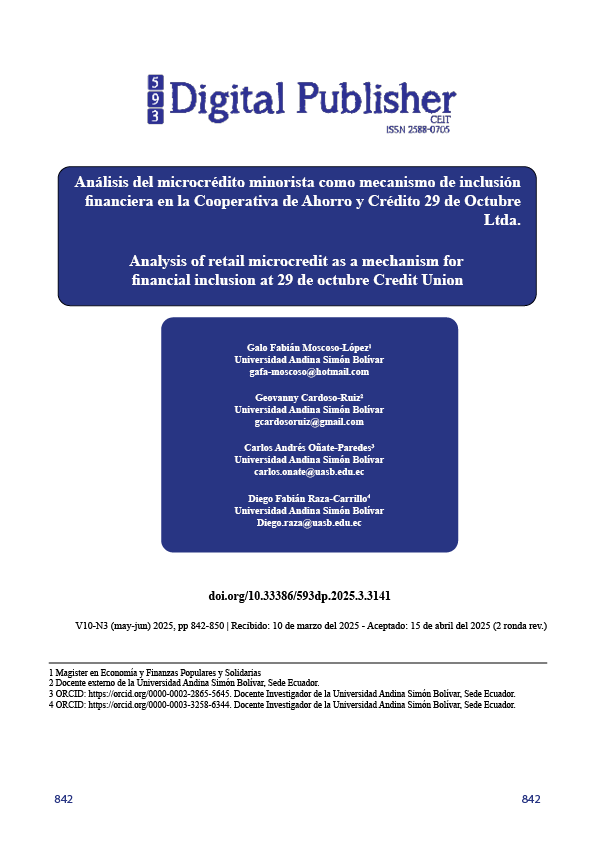Análisis del microcrédito minorista como mecanismo de inclusión financiera en la Cooperativa de Ahorro y Crédito 29 de Octubre Ltda.
Contenido principal del artículo
Resumen
El presente trabajo se llevó a cabo en la Cooperativa de Ahorro y Crédito 29 de Octubre Ltda., con el fin de analizar el producto microcrédito, en particular, el microcrédito minorista dentro del contexto de inclusión financiera y en el período de la pandemia COVID-19. Se analizaron aspectos de este producto como créditos otorgados por edad, género, formación, destino de los créditos, y competencia en el sector financiero.
Se realizó un análisis descriptivo desde enero de 2020 a diciembre de 2022, en el cual se pudo evidenciar que el microcrédito minorista representa el 18% del total de microcréditos otorgados. La cooperativa analizada otorga, en su mayoría, microcréditos minoristas al género masculino y, en cuanto a edad, predominan socios hombres y mujeres entre 35 a 50 años que han alcanzado una educación secundaria.
El crecimiento del producto microcrédito minorista representa un incentivo para la inclusión financiera y recuperación de la economía en el contexto post pandemia; no obstante, se evidencia que la cooperativa al conceder, en su mayoría, créditos de consumo, tiene aún el reto de direccionar sus recursos hacia la atención de sectores con menor inclusión financiera y crear productos de crédito y ahorro enfocados en sectores vulnerables.
El trabajo realizado, mediante el análisis de las variables revisadas, permitió determinar que la Cooperativa de Ahorro y Crédito 29 de Octubre Ltda no logra cumplir satisfactoriamente con el objetivo de inclusión financiera para los productores clasificados en el segmento de microcrédito minorista.
Descargas
Detalles del artículo

Esta obra está bajo una licencia internacional Creative Commons Atribución-NoComercial-CompartirIgual 4.0.
1. Derechos de autor
Las obras que se publican en 593 Digital Publisher CEIT están sujetas a los siguientes términos:
1.1. 593 Digital Publisher CEIT, conserva los derechos patrimoniales (copyright) de las obras publicadas, favorece y permite la reutilización de las mismas bajo la licencia Licencia Creative Commons 4.0 de Reconocimiento-NoComercial-CompartirIgual 4.0, por lo cual se pueden copiar, usar, difundir, transmitir y exponer públicamente, siempre que:
1.1.a. Se cite la autoría y fuente original de su publicación (revista, editorial, URL).
1.1.b. No se usen para fines comerciales u onerosos.
1.1.c. Se mencione la existencia y especificaciones de esta licencia de uso.
Citas
Bakhtiari, Sadegh. (2006). “Microfinance and Poverty Reduction: Some International Evidence”. International Business & Economics Research Journal (IBER) 5, n.o 12. https://doi.org/10.19030/iber.v5i12.3550.
Banco Central del Ecuador - BCE. (2024). Tasas de interés activas efectivas referenciales. Disponible en: https://contenido.bce.fin.ec/documentos/Estadisticas/SectorMonFin/TasasInteres/Indice.htm
Banco Mundial. 2018. “Inclusión financiera”. World Bank. https://www.bancomundial.org/es/topic/financialinclusion/overview.
Banco Interamericano de Desarrollo. (2010). “Microfinanzas”. IADB. https://www.iadb.org/es/microfinance/microfinanzas-0.
Bustamante, Katty, y Carina Cabrera. (2017). “Microcrédito, microempresa y educación en Ecuador. Caso de estudio: cantón Zamora”. Revista Espacios 38 (53). https://www.revistaespacios.com/a17v38n53/a17v38n53p25.pdf.
Carvajal-Salgado, Ana Luisa, y Leonela Espinoza-Párraga. (2020). “Microcréditos ecuatorianos: incentivo a la reducción de la pobreza y mejora del ingreso familiar”. Revista Vínculos ESPE 20 (5). https://journal.espe.edu.ec/ojs/index.php/vinculos/article/view/1671.
Chafla, Jonathan, Jefferson Guamán, y Segundo Evas. (2019). “Análisis de los microcréditos en las Cooperativas de ahorro y crédito de Ecuador”. Revista mktDescubre - ESPOCH FADE.
Cumbre Mundial del Microcrédito, Fundación Iberoamericana para el desarrollo (FIDE) y Agencia Española de Cooperación Internacional para el Desarrollo. (2012). Microfinanzas: V cumbre mundial del microcrédito; Campaña el microcrédito en Iberoamérica: Una herramienta para el desarrollo. Madrid: Fundación Iberoamericana para el Desarrollo: AECID.
Gutiérrez Nieto, Begoña. (2006). “El microcrédito: dos escuelas teóricas y su influencia en las estrategias de lucha contra la pobreza”. CIRIEC-España, Revista de Economía Pública, Social y Cooperativa, (54): 167-86.
Jácome Estrella, Hugo de Jesús. (2021). Inclusión financiera en Ecuador: el cooperativismo de ahorro y crédito como alternativa. Santiago de Compostela: Grupo de Análise Territorial. https://biblio.flacsoandes.edu.ec/libros/152075-opac.
Junta de Política y Regulación Financiera - JPRF. (2023). Resolución N. JPRF-F-2023-086. Disponible en: https://jprf.gob.ec/wp-content/uploads/2023/11/86.-Res.-No.-JPRF-F-2023-086-SEGMENTOS-VF-signed-signed.pdf
Kabeer, Naila. (2001). “Conflicts Over Credit: Re-Evaluating the Empowerment Potential of Loans to Women in Rural Bangladesh”. World Development 29 (1): 63-84. https://doi.org/10.1016/S0305-750X(00)00081-4.
Marulanda, Beatriz. (2005). “Del microcrédito a las microfinanzas en Colombia”. Fedesarrollo. http://www.repository.fedesarrollo.org.co/handle/11445/913.
Rosenberg, Richard. (2002). “Microcredit Interest Rates.” Microfinance Institutions, n.o 1: 24.
Salinas Vásquez, Juanita. (2011). “Ecuador, microcrédito: ¿Negocio o inclusión financiera? “. Retos 1 (2): 40. https://doi.org/10.17163/ret.n2.2011.06.
Superintendencia de Bancos - SB. (2024). Glosario de Términos. Disponible en: https://www.superbancos.gob.ec/bancos/glosario-de-terminos/
Superintendencia de Economía y Finanzas Populares y Solidarias - SEPS. (2024). Estadísticas SEPS. Disponible en: https://estadisticas.seps.gob.ec/index.php/estadisticas-sfps/
United Nations. (2024). Año Internacional del Microcrédito. Disponible en: https://www.un.org/es/events/pastevents/microcredit/
Vereda del Abril, Antonio. (2011). “Aportaciones del microcrédito para la erradicación de la pobreza y el inicio del desarrollo que toma la opción de las mayorías”. Revista española de desarrollo y cooperación, n.o Extra 28: 123-8.





